Energy, Work & Power 2
- The diagram below shows an object of mass \(10\; \text{kg}\) being pulled for a distance of \(3\; \text m\) by a force of \(30\; \text N.\)

The work done is
(A) \(9\; \text J\)
(B) \(30\; \text J\)
(C) \(90\; \text J\)
(D) \(300\; \text J \)Correct = C
- A box of weight \(50\; \text N\) is pulled \(2\; \text m\) along a horizontal floor by a force of \(10\; \text N\) and then the box is lifted vertically through a height of \(1\; \text m\) (see sketch below).
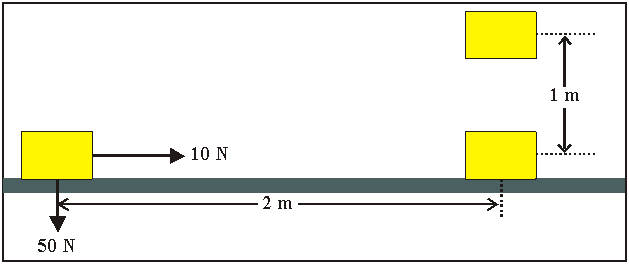
What is the total work done on the box?
(A) \(35\; \text J\)
(B) \(55\; \text J\)
(C) \(70\; \text J\)
(D) \(110\; \text J\)Correct = C
- Two skiers \(S\) and \(T\) have identical masses. They begin from rest from the top of a hill at point A and move to the ski resort. Skier \(S\) takes route 1 and skier \(T\) takes route 2, as shown in the sketch. Which one of the following statements concerning the speed with which \(S\) and \(T\) reach the ski resort is correct? Ignore all friction forces.
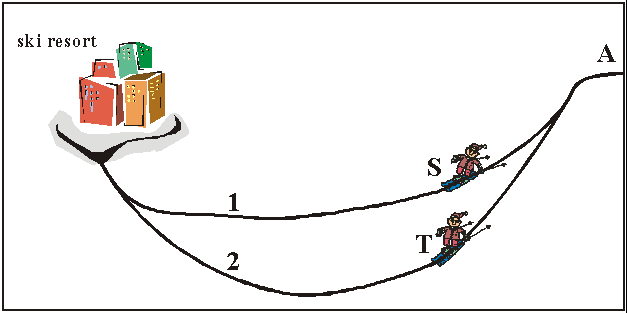
(A) \(S\) and \(T\) both have a speed of zero.
(B) \(S\) and \(T\) both have the same speed.
(C) The speed of \(S\) is smaller than the speed of \(T\).
(D) The speed of \(S\) is greater than the speed of \(T\).Correct = B
- During the latter part of the motion of a rocket its mass is halved because the fuel is used up, while its velocity increases by a factor of 10. By what factor does the kinetic energy of the rocket increase during this stage?
(A) 5
(B) 10
(C) 50
(D) 100Correct = C
- An object of weight \(W\) is lifted vertically through a distance h by a cable hanging from a helicopter. The helicopter accelerates upwards and the tension in the cable is \(T.\)
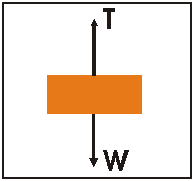
The work done on the object and the type of energy that this work is converted into, is …
Answer work done on the object work done converted into (A) \(T \cdot h\) potential energy (B) \((T - W) · h\) potential energy (C) \(T · h\) potential and kinetic energy (D) \((T - W) · h\) potential and kinetic energy Correct = C
- Two toy cars \(X\) and \(Y\) of mass \(m\) and \(2m\) respectively are at rest at point A. They are allowed to run down a smooth frictionless track. As the cars pass point B, how will their velocities compare?
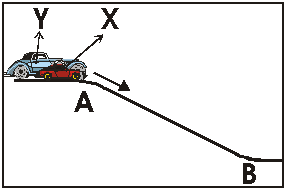
(A) \(v_x = v_y\)
(B) \(v_x = 2\; v_y\)
(C) \(2\; v_x = v_y\)
(D) \(4\; v_x = v_y\)Correct = A
- When a racing car brakes heavily, coming to a halt, into what form of energy is its kinetic energy transformed?
(A) potential energy
(B) kinetic energy
(C) elastic energy
(D) internal energyCorrect = D
- Observe the pendulum in the drawing to the right. At the highest point A of its swing the ball has \(500\; \text J\) potential energy in respect to its lowest point. At the lowest point B of its swing the ball has \(500\; \text J\) kinetic energy.
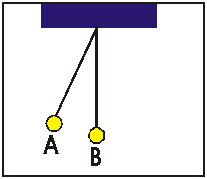
The total mechanical energy of this system is …
(A) \(0\; \text J\)
(B) \(250\; \text J\)
(C) \(500\; \text J\)
(D) \(1000\; \text J\)Correct = C
- Two children \(A\) and \(B\) of equal masses are at a swimming bath. Child \(A\) drops vertically from a diving board \(5\; \text m\) high. Child \(B\) slides from the same height down a slide into the water. The children start moving at the same instant. Which one of the following statements is true? (Ignore air resistance and friction on the slide.)
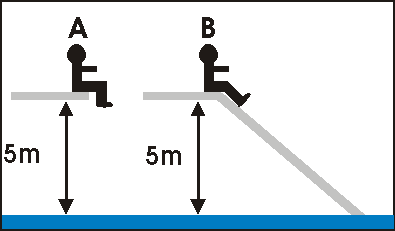
The children hit the water …
(A) at the same time with the same speed
(B) at different times with the same speed
(C) at the same time with different speeds
(D) at different times with different speedsCorrect = B
- An object is dropped from the top of a high building and falls freely to the ground. Which one of the graphs below best represents both its potential energy and kinetic energy as functions of the time fallen by the object?
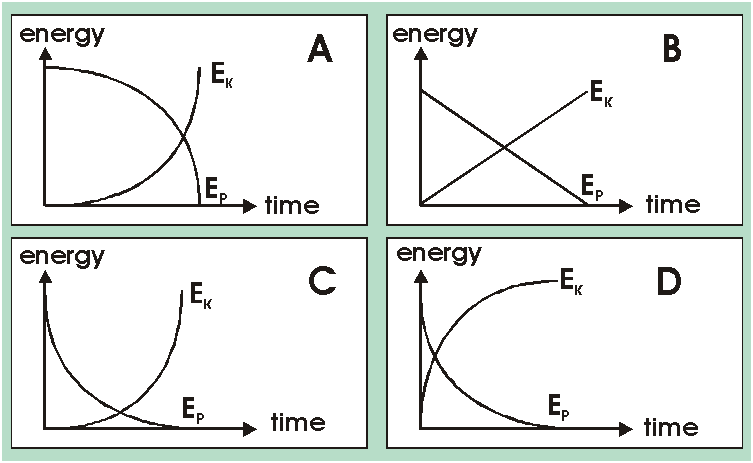
(A) A
(B) B
(C) C
(D) DCorrect = A







